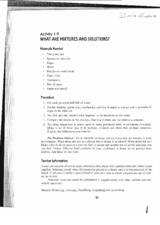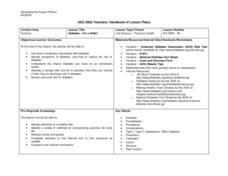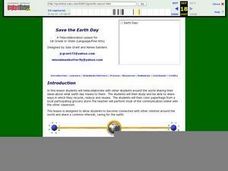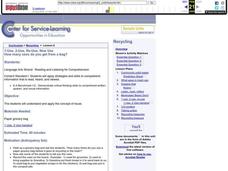Curated OER
What Are Mixtures And Solutions?
Students explore mixtures and solutions. In this chemistry lesson plan, students will add different ingredients to jars in order to classify them as mixtures or solutions. There is also a nail balancing activity that can be done at...
Curated OER
By the Pound
Agriculture surrounds us every day; incorporate measuring tools into a study of Oklahoma's agricultural industry! Small groups read an informational text (included) before visiting stations where they investigate prices of various...
Curated OER
How Far Will You Go And How Much Will It Cost?
Students examine how places of various size function as centers of economic activity. They develop a list of things that families shop for, analyze a local map, create a chart demonstrating how far they travel for the items they listed,...
Curated OER
Sequential Directions
Students demonstrate how to give clear directions when drawing a map to a specific location. In this map skills lesson, students create a map to a location, such as their school, and write down clear directions to the destination.
Curated OER
Understanding Pronouns
Students explore pronouns. In this English grammar lesson, students examine the use of personal pronouns and complete a worksheet regarding singular and plural personal pronouns.
Curated OER
Natural Features as a Resource
Students research how people use land and water features to meet their basic needs. For this natural features lesson, students review land and water features. Students discuss how the land is used to meet needs using a landscape picture...
Curated OER
Balanced Meal Planner
Learners use an online website to select foods and put them onto a plate to see if they have made healthy and balanced meals. In this healthy meals lesson plan, students review the food pyramid before this activity.
Curated OER
Astronomical Scales
High schoolers describe the different units of measurement. In this space science lesson, students calculate astronomical distances using a scale. They explain the significance of using scientific notation in expressing very small...
Curated OER
Giants Stalk the High Street
Students explore consumerism in Great Britain. For this current events lesson, students visit selected websites to determine how shopping habits have changed in Britain throughout the years. They also evaluate changes in market shares of...
Curated OER
You'd Better Shop Around
Students compare and contrast the prices of various food items at different grocery stores using newspaper advertisements. Students discuss the benefits and drawbacks of shopping around for items that fit within their monthly budget.
Curated OER
Diabetes - It's a Killer!
Students survey, graph and chart their prior knowledge about diabetes. They read a handout and complete a K-W-L chart. They develop a rubric to assess their diet and exercise and develop a shopping list, menu and exercise plan to share.
Curated OER
Field Crops in the Food System
Students complete activities related to food production and distribution. In this agriculture lesson, students read and discuss the crops grown in Iowa and Wisconsin and the ways the crops are used. They complete activities related to...
Curated OER
Who's In The Bag?
Learners bring in a bag from home with personal items. In this ice breaker lesson, students bring 10 personal items to school. The teacher shows them, asks the learners questions, and has them guess as to the owner of the bag.
Curated OER
Where Does Food Come From?
Distinguish between food and non-food items. Recognize that food is obtained from both plant and animal sources. Identify sources for some common animal foods then construct a simple food path from the farm to the consumer.
Curated OER
Save the Earth Day
First graders tellacollaborate with other students around the world sharing their ideas about what earth day means to them. They share ways in which they recycle, reduce and reuse.
Curated OER
Making Choices to Save Money on Food
Young scholars review lists of coupons and complete a worksheet to analyze the benefits of the specials. In this household budget instructional activity, students determine which foods are nutritional and the advantages of using coupons...
Curated OER
Movies In Your Head
Learners participate in a reading literacy lesson that focuses on the skill of visualization and the metaphor of a movie is used to explain images in the mind. This lesson teaches children how to make a movie in their head from what is...
Curated OER
1-Use, 2-Use, Re-Use, New Use
Students list the possible uses of grocery bags. They trace the steps of a grocery bag either to recycle or trash. In groups, students use the grocery bags to create posters promoting reuse.
Curated OER
Removing the 'Junky' Words
Students explore was to comprehend a story through summarization. They are introduced to a lesson by explaining that when we read there are a lot of extra, unnecessary, junk words. Students explore ways not pay to attention to the...
Curated OER
Changes in the Community
Students research the history of the ethnic diversity of Ohio when exploring the changes in the community. They analyze the history of Native Americans in the region as well. The role of school is analyzed as well within this lesson.
Curated OER
Social Studies: Cameroon
Young scholars discover the history of Cameroon and compile a list of foreign foods found in their local grocery. After taking notes on a lecture, they brainstorm a list of foods they might find on a trip to the country and compare it to...
Curated OER
MOBILITY, Traveling Lightly: What’s My Footprint?
Young scholars calculate their carbon footprint. In this environmental technology lesson, students listen to a lecture on climate change. Young scholars brainstorm solutions to reduce environmental impact based on travel options....
Curated OER
Vitamin Planet
Students explain the function of vitamins in their body. In this health lesson plan, students identify the six types of vitamins. They create a chart comparing two of them.
Curated OER
Finding Rates
Fifth graders explore the concept of rates and how to solve them in problems. They solve the problems using multiplication. The majority of the lesson is direct instruction with the students being included in the process.

























